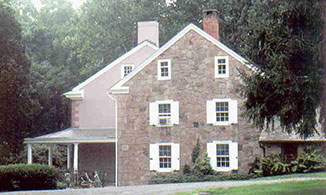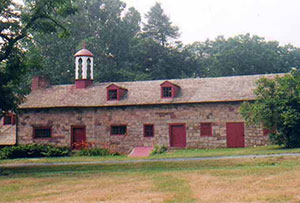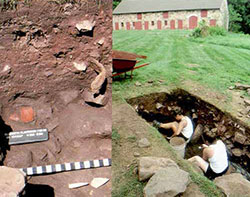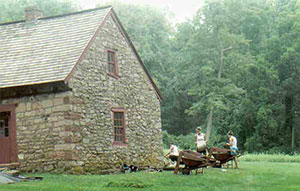 |
| The Coleman (background)and Stiegel (foreground) mansions at Elizabeth Furnace Plantation. The Stiegel mansion was built in 1757, while the Coleman mansion was constructed about 1788. |
The Elizabeth Furnace Plantation is an 18th century treasure. Thirteen colonial-era buildings, constructed between 1746 and 1788, are still standing in the 10-acre core of the property. In fact, the 1788 Coleman mansion is the newest standing structure on the property today, which has seen no new buildings erected since the 18th century. The buildings are in exceptional condition, with original woodwork, windows, sashes, summer beams, and fireplaces; the windows of the "Hessian barracks" building still contain the iron bars placed there during the Revolutionary War when the building housed prisoners. Because of the large number of original buildings in remarkably unchanged condition, and in light of the total absence of newer construction, Elizabeth Furnace Plantation may be one of the best-preserved Colonial-period villages in the United States. The plantation grounds have remained in private hands from the 18th century until today, and as a result, the public and most scholars are unaware of the existence of this rare survivor. In the summer of 2005, the archaeology program of Millersville University began the first archaeological excavations ever undertaken at this site. If you are interested in the history of the property or Millersville University's archaeological excavations, it is the University's hope that you will continue reading. However, you are asked to respect the fact that the site is on private property, and is not open to public tours or visitors at this time.
The Built Environment
The surviving colonial-era buildings at Elizabeth Furnace Plantation can be viewed as essentially the heart of a colonial-era village, which grew up around the central industry of the furnace and ironworks. The large number of workers required for the furnace necessitated workers housing, plantation-style outbuildings and farmlands to produce food: a creamery and dairy, multiple cold cellars for food storage, at least two blacksmith shops, a glasshouse, and even a general store which was still in operation as late as the 1830's. While the furnace was the central economic focus of the property, it was such a large undertaking for the time (particularly when it is considered that this was prior to the large-scale industrialization of the 19th century), the infrastructure of an entire colonial village was required to facilitate its operation. Unlike most villages, however, all of the houses, fields, and industries were in the possession of the furnace owners.

The oldest building on the property is the Huber House (ca. 1746), which was the home of the furnace founder, John Jacob Huber. Built in vernacular German style, its original central chimney is no longer present. Of the four buildings originally comprising the furnace itself, only the charcoal house (ca. 1750) remains. The Stiegel mansion, an attached summer kitchen, an office, the aforementioned Hessian barracks, the stables, and the icehouse, all date to the 1750's and early 1760's and are remarkably original in terms of the historic fabric of the buildings. At least four tenant houses, most likely dating from the 1750's to the 1780s, still stand in various locations around the property including two in the core area.
From the perspective of historical archaeology, the buildings that are not still standing are possibly even more impressive than the surviving structures. Each is an archaeological site, which given the absence of subsequent building on the property, presents the strong possibility of undisturbed archaeological deposits. These deposits represent the words, paragraphs, and chapters of the history of the people who lived at Elizabeth Plantation Furnace- a history that can be recovered through archaeological excavation and analysis. Each of the myriad of sites scattered throughout the grounds, therefore represents an opportunity for research into the colonial period in Lancaster County. Buildings which were once part of the Elizabeth Furnace Plantation village, and which appear on historic maps of the property but are no longer standing today, include at least eleven tenant houses, two blacksmith shops, a creamery / dairy, a colonial-era glassworks, and a general store. It is probable that many other buildings yet to be discovered once stood on the property, as well.

Historical Background
In 1746, John Jacob Huber patented 400 acres of land in northern Lancaster County. As early as 1750 he had built and put in blast a furnace, where he cast five-plate stoves for the Pennsylvania market. His stoves, some of which survive today, were cast with the confident inscription (in German) "John Jacob Huber, the first German man who can manage ironwork". In 1752, Huber's daughter Elizabeth married a young German employee of her father. Heinrich Wilhelm Stiegel would later become famous for his audacious decorative glassworks in Manhiem, his name synonymous with some of the most highly collectible colonial-era decorative glass in America. Stiegel bought out his father in law's interest in Elizabeth plantation in 1757 and with backing from wealthy Philadelphia investors, constructed most of the buildings that survive in the core of the property today. He also rebuilt the furnace and renamed it Elizabeth Furnace for his wife, the daughter of its founder. Stoves cast here by Stiegel still survive today, including one in Stiegel's office on the property inscribed "Elizabeth Furnace 1769".
Stiegel was legendary for his flamboyance. He owned, at one point, more than 2000 pounds worth of musical instruments for his personal marching band, and constructed a 75 foot stone tower with a cannon mounted on top of a nearby hill, so as to grandly salute when he entered the Elizabeth Furnace village. His extravagance eventually cost him Elizabeth Furnace Plantation as well as his Manhiem glassworks, and he landed in debtors prison in Philadelphia by the early 1770's. After losing money for some years, Stiegel's creditors eventually leased the furnace to a young ironmaster named Robert Coleman.
Coleman rid the operation of the inefficiencies of the Stiegel period, undertook significant new construction to improve the efficiency and output of the furnace, and quickly turned the venture into a highly cost-effective operation. Coleman managed the furnace so ably he was able to earn enough to purchase the property, moving from renter to owner before his initial 7-year lease was up. The mansion Coleman built in 1788 remains, incredibly, the newest standing structure on the property today.
Archaeological Research

The Lancaster Colonial Settlement Project at Millersville University began initial archaeological testing at Elizabeth Furnace Plantation in the summer of 2005. Due to the sheer size and diversity of resources of the plantation, it was decided to concentrate on one area of the property for this initial look into the archaeological potential of the site. The area around the John Jacob Huber house (ca. 1746) has been chosen for this initial project.
Archaeological testing, though highly preliminary, has already revealed areas of significance. We have learned that the grounds immediately west, south, and east of the Huber house were heavily disturbed sometime during the early 20th century, possibly relating to the destruction of most of the tenant houses. It appears, however, that the original furnace race (the stream-channel dug to carry water to power the wheel of the furnace) was too deep below ground level to have been destroyed by this action. Excavations revealed a rich layer of artifacts in a sealed context, in the silted-in bed of this 12-15 foot wide channel. Since the channel was located within 15 feet of the back of the Huber house, it appears that items deposited by the people living in the house wound up in the base of this channel, and should provide valuable insight into the daily lives of the people who lived there. Excavations also indicated that the area to the east, immediately down-slope from the Huber house, was not disturbed by the 20th century activity in the area.



